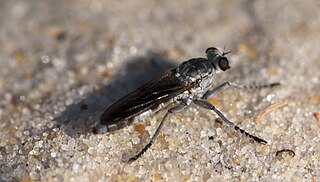
Cercocarpus, commonly known as mountain mahogany, is a small genus of at least nine species of nitrogen-fixing flowering plants in the rose family, Rosaceae. They are native to the western United States and northern Mexico, where they grow in chaparral and semidesert habitats and climates, often at high altitudes. Several are found in the California chaparral and woodlands ecoregion.

Leptopelis argenteus, also known as the silvery tree frog or triad tree frog, is a species of frog in the family Arthroleptidae. It is found in coastal Kenya and Tanzania and south to northern Mozambique, southern Malawi, and eastern highlands of Zimbabwe.

Leptopelis broadleyi is a species of frog in the family Arthroleptidae of uncertain status. The Amphibian Species of the World, the IUCN SSC Amphibian Specialist Group, and the African Amphibians do not recognize it, but instead consider it synonym with Leptopelis argenteus. However, the AmphibiaWeb recognizes it as a valid species.

The Japanese dormouse is a species of rodent in the family Gliridae endemic to Japan. It is the only extant species within the genus Glirulus. Its natural habitat is temperate forests. In Japanese, it is called yamane. Among dormice, it has the special ability of running at great speed upside down, suspended from branches. Its main food is fruit, insects, berries, nuts, and even flowers. It tends to inhabit arboreal nesting sites to avoid interspecific competition with the small Japanese field mouse because of their sympatric relationship.

Stichopogon is a genus of small robber flies of the subfamily Dasypogoninae. There are at least 100 described species in Stichopogon.

Euceratocerus is a genus of death-watch beetles in the family Ptinidae. There are four described species in Euceratocerus.

Staphylococcus is a genus of Gram-positive bacteria in the family Staphylococcaceae from the order Bacillales. Under the microscope, they appear spherical (cocci), and form in grape-like clusters. Staphylococcus species are facultative anaerobic organisms.

Cercocarpus montanus is a North American species of shrub or small tree in the family Rosaceae native to northern Mexico and the western United States. It is known by the common names alder-leaf mountain-mahogany, alder-leaf cercocarpus, and true mountain-mahogany. The variety argenteus is commonly known as silverleaf mountain-mahogany.

Bluebonnet is a name given to any of a number of purple-flowered or blue-flowered species of the genus Lupinus predominantly found in southwestern United States and is collectively the state flower of Texas. The shape of the petals on the flower resembles the bonnet worn by pioneer women to shield them from the sun. Species often called bluebonnets include:

Gadiculus argenteus, or the silvery pout, is a species of cod found in the Northeast Atlantic region. It grows to a length of 15 cm (5.9 in) and is of minor importance to local commercial fisheries, being rather used as a bait fish.

Pipturus argenteus, known as false stinger, native mulberry, white mulberry, white nettle, amahatyan (Chamorro), and ghasooso (Carolinian), is a small tree native to tropical Asia, northern and eastern Australia and the Pacific.
The southern groove-toothed moss mouse is a species of rodent in the family Muridae found in Southern Papua New Guinea. As opposed to M. richardsoni, argenteus sp can be differentiated most prominently by its gray-brown pelage.

Stichopogon abdominalis is a species of robber fly in the family Asilidae.
Stichopogon colei is a species of robber flies, insects in the family Asilidae.

Stichopogon trifasciatus, the three-banded robber fly, is a species of robber flies, insects in the family Asilidae.
Stichopogon fragilis is a species of robber flies, insects in the family Asilidae.

Stichopogon catulus is a species of robber fly in the family Asilidae.

The flat-tail mullet is a species of grey mullet from the family Mugilidae. It is endemic to southern Australia where it forms schools in shallows, and lower estuaries, as well as in more saline lagoons. It spawns at sea but juveniles move into freshwater until they are a year old. It feeds on benthic microorganisms such as crustaceans and filamentous algae. It is caught as a food fish. It is the only species in the monospecific genus Gracimugil.

Mimetes argenteus is an evergreen, upright, hardly branching, large shrub of about 2 m (6½ ft) high in the family Proteaceae. It has elliptic, silvery leaves, due to a dense covering of silky hairs, that stand out a right angle from the branches. It has cylindric inflorescences of 8–15 cm (3–6 in) long and 10–12 cm (4–5 in) in diameter, crested by smaller silvery pink leaves at an upright angle. These consist of many flower heads, each containing six to nine individual flowers and ar set in the axil of a leaf flushed mauve to carmine. It flowers from March to June. The silver pagoda naturally occurs in the Western Cape province of South Africa. It is called silver pagoda or silver-leaved bottlebrush in English and vaalstompie in Afrikaans.















